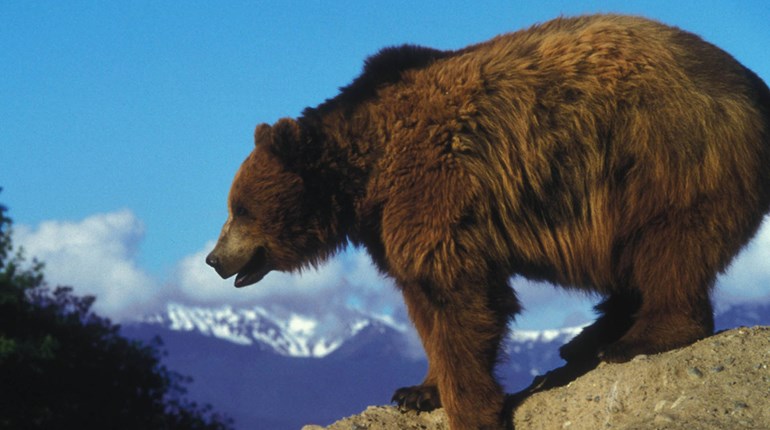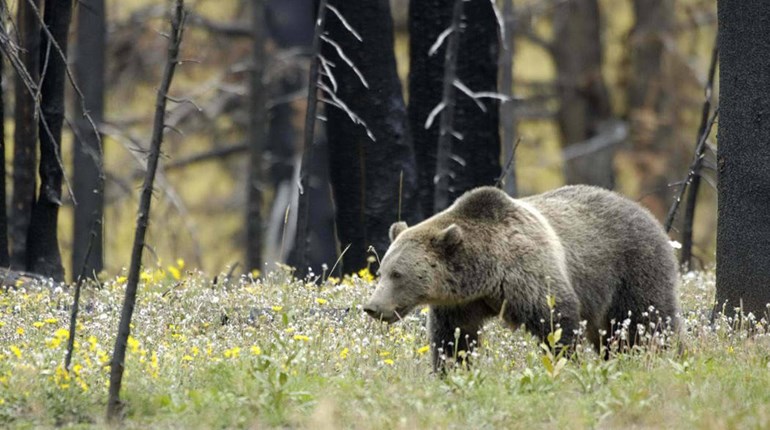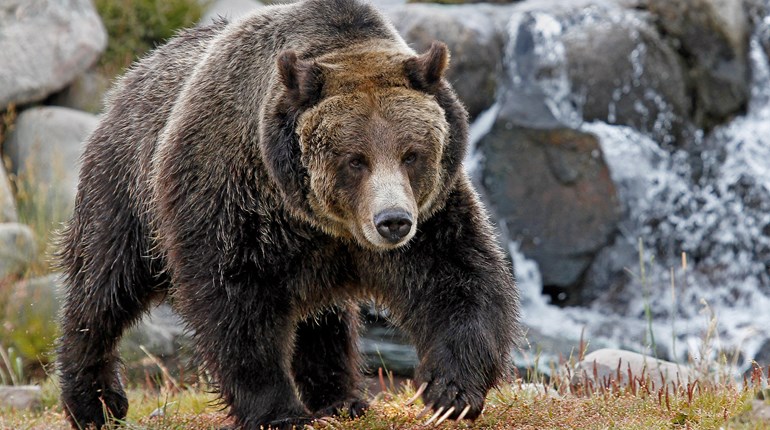
Alaska! The word, the place, the mystique gets the world’s outdoor enthusiasts’ adrenaline pumping. It’s 16 times as big as my birth state of Kentucky but holds far less people than metro Louisville alone. Wyoming even has nearly six times the population density of Alaska. Overlay Alaska on the contiguous 48 states and the edges would rest over Minnesota, Texas, Florida and California! Alaska has more caribou than people. Alaska’s coastline is longer than that in the remaining 49 states combined. It has the highest mountain on the continent. But when it comes to wild and woolly, one thing screams wilderness more than any other: griz—30,000 of them.
In mid-November 2012, Brig. Gen. Blake Gettys, out on his trap line near his Kenai Peninsula cabin, was startled by a bear grunt off to his left. He turned to see the silhouette of a large bear some 20 yards away … it was a boar, he thought, based on its size and shape and some tracks he had seen earlier. The bear was moving next to the treeline and was in the 5 p.m. shadows due to the setting sun. He turned to face the animal and, like we all were taught 20-30 years ago, raised his arms and shouted in an attempt to scare it off. The grizzly roared, exploding into a full charge as it arched around the bend in the trail, coming in low with paws reaching out past its outstretched head. At 50 fps, the griz covered the distance in 2 seconds, maybe less.

Gettys was not idle. He immediately recognized his peril. But with many decades of innumerable harmless griz encounters, he was in shocked disbelief that this encounter was going to be different. And different it was.
Being unarmed with no trees to climb or hide behind, Gettys (ex-player and later coach at the U.S. Air Force Academy football team), standing 6-foot-2 and weighing 220 pounds with a 34-inch waist and 48-inch chest, readied himself like Paul Bunyan for the impact. His arms were outstretched towards the bear with knees bent. He continued to yell in hopes that this would result in a false charge—it didn’t. As the 800-pound (based on the width of its claw marks) bear leaped for him, it seemed at least 4 feet wide. In that micro-second Gettys stepped forward and to the right, hoping the bear would miss him. The action appeared to have worked as the bear’s head rocketed by low and to his left. As the boar shot past the man, it twisted to its left, swung its right front paw back at him and managed to hook the inside of his left thigh with one of its 5-inch claws. That claw went down to Gettys’ femur and nearly cut his thigh to the bone most of the way around. The impact of that claw attached to 800 pounds of griz at 35 mph lifted Gettys into the air and brought him down with such force that the impact shook the ground and was so loud Brian, his hunting/trapping buddy, some 75 yards away, thought a large white spruce had fallen. As if by divine intervention, the claw slipped off Gettys’ thigh a quarter-inch before severing his femoral artery. Hooking Gettys slowed the bear’s momentum, so it now faced the prostrate and addled general ready to renew its attack.
Apex predators know their profession; victims of griz attacks invariably get scalped and/or have their face bitten off (few animals have any fight left in them after such treatment). This mature boar was no different. Long before the battered Gettys recovered from the first impact, it attacked his face ferociously with the terrific impact of its wide-open jaws on the man’s face and skull. The bear snapped shut its huge jaws with lower canines hooked on the outside of Blake’s right jawbone while its upper canines cut his scalp above his left temple. The trapper attempted with limited success to force his left hand and forearm into the right corner of the bear’s mouth to try to prevent it from closing and thus save his face. But the bear’s jaws clamped shut and cut the skin on his forehead down to the bone. The force of the bite cut across both eyebrows and through the bridge of his nose, slicing along his entire left nostril and through his nasal septum. Most of the general’s face, including his nose and eyebrows, hung from the bone in tatters. When Blake got the bear to release its grip, it immediately raised its head only to come crashing down once again. Blake pulled up his right knee to his chest and used his left arm to try to protect what was left of his face. Taking the bait, the bear repeatedly made bone-crushing chomps on that left arm and then, characteristically, shifted its attention to the unprotected scalp and locked its bite above his forehead. In his regular “only the facts” speech, Gettys clearly recalled the sound of the bear’s teeth grating on his skull. Again, this time successfully, he used both arms to pry its jaws free of his head.
 On its first rush, the bear tore Gettys’ left thigh from back to front. Its claw jumped over his artery and vein or else he’d have bled out in 15 seconds.
On its first rush, the bear tore Gettys’ left thigh from back to front. Its claw jumped over his artery and vein or else he’d have bled out in 15 seconds.
The bear paused briefly and stood straddling the man’s upper body, staring toward the nearby Kenai River. As the ex-offensive lineman surveyed his situation, it struck him that two more men as big as him could fit between the grizzly’s giant forepaws. Blake heard a cub bawling in the distance (so it was a sow!) and his partner Brian yelling from the direction of the river. In his confusion, the general could not understand how Brian could be getting mauled at the same time the bear was on top of him. The bear’s face hung less than 2 feet above Blake’s left shoulder; its mouth was open and dripping bloody saliva. During the pause in the attack, Gettys wondered how long she would keep this up. Strength was rapidly fading from the powerful outdoorsman, having already sustained a great deal of damage. At that moment, the sow leaped from her position over him and moved in the direction of Brian’s yelling.
We all should put a lot of thought into who we take with us when we go afield. Blake chose well as Brian’s yelling never ceased. He, too, was unarmed but he ran toward the sound of the attack.
Most of the general’s face, including his nose and eyebrows, hung from the bone in tatters. When Blake got the bear to release its grip, it immediately raised its head only to come crashing down once again.
When Brian saw the bear biting at Blake’s face he ran even closer to the bear, yelling the whole time, to get her attention. Indeed he did, and the enormous sow left the general and charged after Brian who, naturally, reversed course, sprinting down the trail paralleling the river. He did not get far. As he sensed the sow was about to overtake him, Brian dove off the trail into an alder thicket. The sow swatted Brian as he dove, driving him deep into the alders, and absolutely flattening the tough 5-gallon plastic bucket in his backpack. Brian immediately balled up with his back towards the bear. The thick branches prevented the bear from getting on top of Brian. She ripped at him with her claws, cutting his jacket and pants. Other than the bruise from her initial strike, however, Brian was not injured.
Within about 10 seconds, the general felt the ground rumbling and realized the nightmare was not over! Again, wearily, he pulled his right leg to his chest and covered what was left of his face and head with his arms, preparing for another onslaught.
The sow stormed in and chomped down on his right leg immediately below his knee with such tremendous pressure he almost passed out. She released his leg only to bite it again even harder, this time pulling his leg straight as if to dismember it. The enraged sow dropped his lifeless leg and straddled his chest. Blake looked through his protective arms as the bear bent its forelegs to bring down its shockingly huge head for face-to-face scrutiny. She then pushed her upper body off the ground to full standing height, extended her forelegs, put her massive clawed paws together and crashed down with her full 800-pound weight on his chest. Twice! It was as if she was saying, “Stay down if you know what’s good for you!” These blows emptied the general’s lungs and left him defenseless, his arms and legs splayed out. How many of us, I wonder, could have survived that? The sow stared down on him, her face inches from his, their eyes locked. She held her stare for a couple of seconds then turned away and slowly walked off downriver.
 A few years after the attack Blake met and married April. That’s them, above, enjoying a day of fishing at the Kenai River camp.
A few years after the attack Blake met and married April. That’s them, above, enjoying a day of fishing at the Kenai River camp.
Wow! Alaska stood up and exerted her sovereignty on the most physically powerful and highly experienced outdoorsman I know. When I moved to Alaska 40 years ago, its military-heavy population had many Vietnam veterans. One cautioned me, “Griz are like Viet Cong; you don’t know if they are all in Cambodia or right under your hooch.” I know wisdom when I hear it.
So why were these two sourdoughs unarmed along the bank of Alaska’s most famous salmon river? Well, being sourdoughs was part of it. They had literally hundreds of harmless encounters with griz and they were enormously skilled at reading bear behavior and using their well-honed instincts to avoid an encounter. Gettys has a cabin (for the past 22 years) within several hundred yards of the attack site. Therefore he was right in the middle of high-density griz populations for probably 2,000 days of weed whacking, cutting and splitting firewood, fishing, trail cutting, constructing outbuildings, hosting church groups, painting buildings, trapping, partying, etc. Carrying a heavy big-bore revolver when doing lots of hard physical work for thousands of days is a royal pain, especially when the risk of needing it seemed very remote. Plus they both shared a philosophy based on their experience that most of the time the encounter is too harmless to necessitate shooting—and when it is not you don’t have time to use your gun. There are indeed many instances of incredibly experienced Alaska bear guides being mauled or killed with stopping rifles in their hands that they did not have time to use.
Did Gettys survive? Did he change his unarmed philosophy? The answer to both questions is “yes.”
Remember what I said about choosing your hunting buddy with care? Brian, with help of first responders and medical infrastructure, had Blake in the hands of skilled surgeons by 8 p.m., likely saving the general’s life. Blake relayed that he would not have had time to unholster and fire a heavy revolver held on his hip before the bear hit him, but could have used one in a chest holster while it had him down on the ground. He now carries a Smith & Wesson Model 329PD (Personal Defense) Airlite .44 Magnum loaded with 300-grain hard-cast bullets in a Man Gear Alaska chest holster. I live on an inholding inside the 500,000-acre Chugach State Park outside Eagle River, Alaska, and I, too, have bears in my yard most every day of the snow-free months. As a wildlife ecologist, I live here because I delight in having black bears, griz (unfortunately unimpressive and uninspiring “brown bear” is the proper name in the profession but grizzly still fits better for me), wolves, lynx, moose, coyotes, etc., around me. But it simply wouldn’t do for me to be killing anything “in defense of life and property.” So I employ all I can to prevent it short of allowing myself to be eaten alive. To inhibit the latter, my armed-but-able-to-go-about-my-work-somewhat-uncompromised solution is to wear a vest with a pistol chest sleeve holding a Taurus Model 450 snub-nosed Ultra-Lite .45 Colt also with 300-grain hard-cast bullets. Not perfect griz medicine but better than nothing—and I will have it with me unlike larger, heavier, more potent pieces. Plus I am more penny-wise and pound-foolish than Gen. Gettys (retired generals who later retire as 767 pilots have more scratch anyway). What would your solution be?
 Since the attack, Gettys arms himself with a S&W Model 329PD Airlite .44 Mag. loaded with 300-grain hard-casts, carried in a Man Gear Alaska chest rig.
Since the attack, Gettys arms himself with a S&W Model 329PD Airlite .44 Mag. loaded with 300-grain hard-casts, carried in a Man Gear Alaska chest rig.
The Alaska Department of Fish and Game asked if Blake wanted the bear killed (it had an old tracking collar on it and could be positively identified). Blake magnanimously said, “No way; the sow was protecting her cub.” He further said he hoped people could learn from his experience.
In addition to what we learned above, the guidance of yelling and waving your arms to seem big and scary when encountering bears works a lot of the time to drive them off (this was the most common published advice 20-30 years ago). But in the case of grizzly sows with cubs, I know of at least a dozen cases when such behavior resulted in instantaneous charges, as it did in this attack (although Blake initially, logically, pegged it as a boar). Professionally, that makes sense to me, as a sow with cubs that is unconcerned with your presence would be livid if you suddenly seemed large and threatening. More modern guidance is to not yell or wave wildly unless actually approached or charged. Further, you are to play dead, lie on your stomach, cover the back of your neck with your hands and not look it in the eyes if mauling is imminent. While such behavior might have mitigated the severity of Blake’s mauling there is no certainty. For that matter big, powerful and agile Gettys might have deterred the sow by punching it in the nose with all his might. That is probably what he would have done had it been a black bear.
So how about bear spray vs. a large-caliber lightweight pistol? For similar size you could easily carry 30-plus shots vs. one with bear spray. You can signal for help with your pistol but not bear spray. The gun would be far more effective against people (a more likely and dangerous threat). The gun can be used to take game in a survival situation while bear spray cannot. Lastly and most importantly, the gun can be used to deter bears harmlessly long before they get close enough to use bear spray. I once deterred a charging grizzly at 30 yards with a shot from a .44 Mag. S&W Model 629 that sprayed its face with gravel, and I deterred a predatory black bear stalk by shooting in the ground next to the bear’s feet with the .45 Colt Taurus.
 Blake and April Gettys.
Blake and April Gettys.
Well, how did the general fare “post griz?” Blake spent two hours in orthopedic surgery and underwent six more hours of plastic surgery with Dr. Kallman. Kallman was a highly regarded plastic surgeon with a great deal of experience reconstructing brown bear mauling victims who commented that Blake was the second-worst mauling victim he ever “reconstructed.” Several years later the retired general is as strong and vigorous as ever. Further, I wouldn’t quite say he has to beat women off with a stick (this is Alaska you know), but he is once again quite handsome. He’s the only man I know who got even better looking after having his face bitten off by a grizzly bear!





































